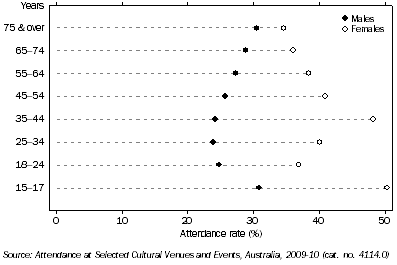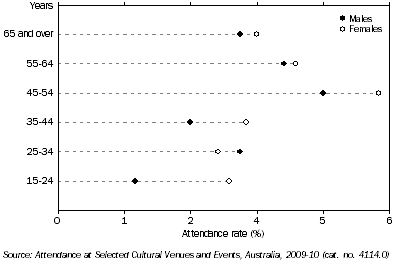 LIBRARY AND ARCHIVE ATTENDANCE
LIBRARY AND ARCHIVE ATTENDANCE
Introduction
Mention the word library and people immediately think of books, but libraries have a lot more to offer. In addition to the array of fiction and non-fiction material available for loan, visitors to today's libraries can engage in a number of other activities including reading magazines and newspapers, accessing the internet, listening to music, borrowing CDs and DVDs, using games consoles and participating in book clubs. The majority of services offered by libraries are free, making a visit to a library an activity anyone can enjoy.
Whilst libraries exist as a direct service to the public, archives exist for the specific purpose of maintaining and preserving important records which have significant historical, cultural or administrative value [Public Record Office of Victoria website]. For example, the National Archives of Australia is home to 'a treasure trove of fascinating records about Australia' [Visit Canberra website]. Members of the public are able to visit archives but the way in which they are able to view the records is strictly governed.
The different appeal of libraries and archives is reinforced by data published in Attendance at Selected Cultural Venues and Events, Australia, 2009-10 (cat. no. 4114.0) [ABS] where one in three people reported visiting a library in the 12 months prior to interview compared with one in twenty five for archives. Information relating to attendance at other cultural activities i.e. art galleries, museums, zoological parks and aquariums, botanic gardens, cinemas and performing arts events, is also available in the above publication. This article presents an overview of libraries and archives.
Libraries
Archives
Libraries
Attendance
With an attendance rate of 34% of the population aged 15 years and over (5.9 million people) in 2009-10, national, state and local libraries were the fourth most attended cultural venue or event in the 12 months prior to interview behind cinemas (67%), zoological parks and aquariums (37%) and botanic gardens (35%).
Unlike most other cultural activities included in the survey, people tended to make multiple visits to the library. Whilst 15% of all attendees reported going to the library once or twice in the 12 months prior to interview, the majority (64%) visited more than five times. One in four people (26%) attended a library more than 20 times.
Area of residence
Residents in most states and territories had similar attendance rates at libraries, ranging from 31% in Western Australia to 38% in the Australian Capital Territory. Only two states showed significant differences in attendance rates between 2005-06 and 2009-10, with decreases recorded for both South Australia (down from 40% to 35%) and Western Australia (37% to 31%).
Characteristics of visitors
Females were far more likely to visit libraries than males, with statistically significant differences in attendance rates found in the majority of age groups. The largest differences were reported by those aged 15-17 years (50% for females and 31% for males) and 35-44 years (48% for females and 24% for males). The differences in attendance rates for those aged 75 years and over were not significant. The overall library attendance rates were 41% for females and 26% for males.
ATTENDANCE AT LIBRARIES, By age and sex
- 2009-10

Looking at other personal characteristics, the highest attendance rates for libraries were reported by people who:
- were born overseas in a main English-speaking country (41%)
- were employed part-time (44%)
- were in households with dependent children, in couple or one-parent families (both 39%)
- had graduate diplomas and certificates (55%) or postgraduate degrees (54%).
Archives
Attendance
Archives had an overall attendance rate of 4% of people aged 15 years and over (0.6 million people). This was the least attended cultural venue or event in the 2009-10 survey. The low attendance rate at archives may be the result of people generally visiting only when they have a specific research purpose in mind.
Most (77%) of those who visited an archive only did so once or twice in the 12 months prior to interview.
Area of residence
With the National Archives based in Canberra, Australian Capital Territory residents had the highest attendance rate at 16%. Attendance rates for the other states and territories were around 4%.
Characteristics of visitors
As with most other surveyed activities, females across the majority of age groups had higher attendance rates at archives than males, although these differences were not statistically significant. Overall males and females had similar archive attendance rates (3% and 4% respectively).
ATTENDANCE AT ARCHIVES, By age and sex
- 2009-10

Findings relating to other personal characteristics include:
- people born in Australia (4%) were twice as likely to visit archives than those born outside Australia (2%)
- those who were unemployed (6%) were more likely to visit archives than those employed (4%)
- one in ten people with a postgraduate degree (11%) visited an archive.
References
Australian Bureau of Statistics
Attendance at Selected Cultural Venues and Events, Australia, 2009-10 (cat. no. 4114.0)
Public Record Office of Victoria website
Visit Canberra website
 Print Page
Print Page
 Print All
Print All